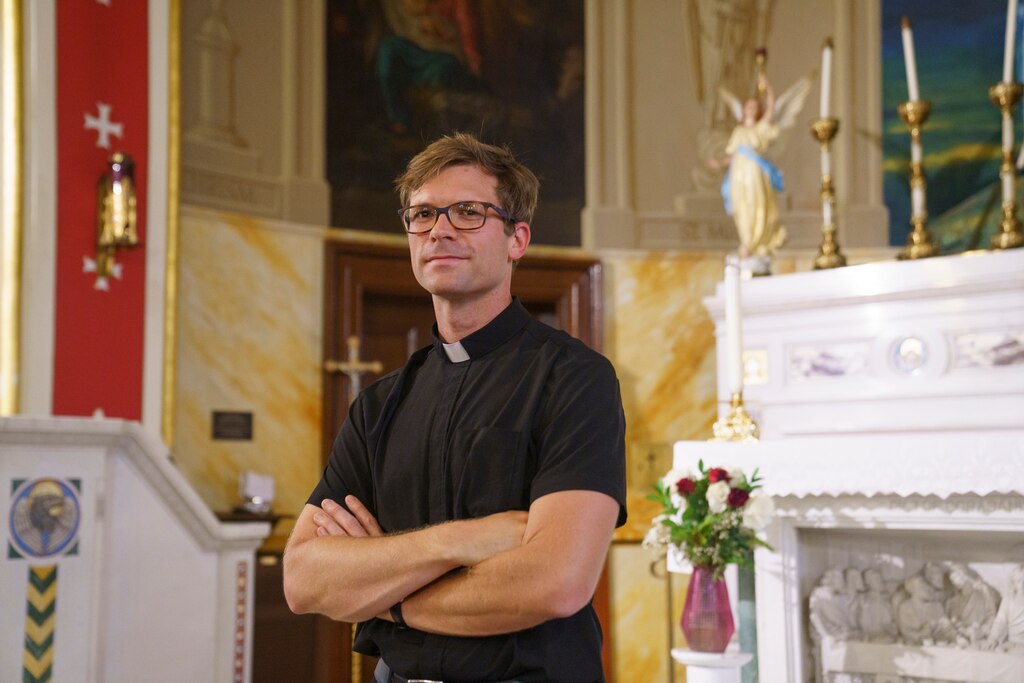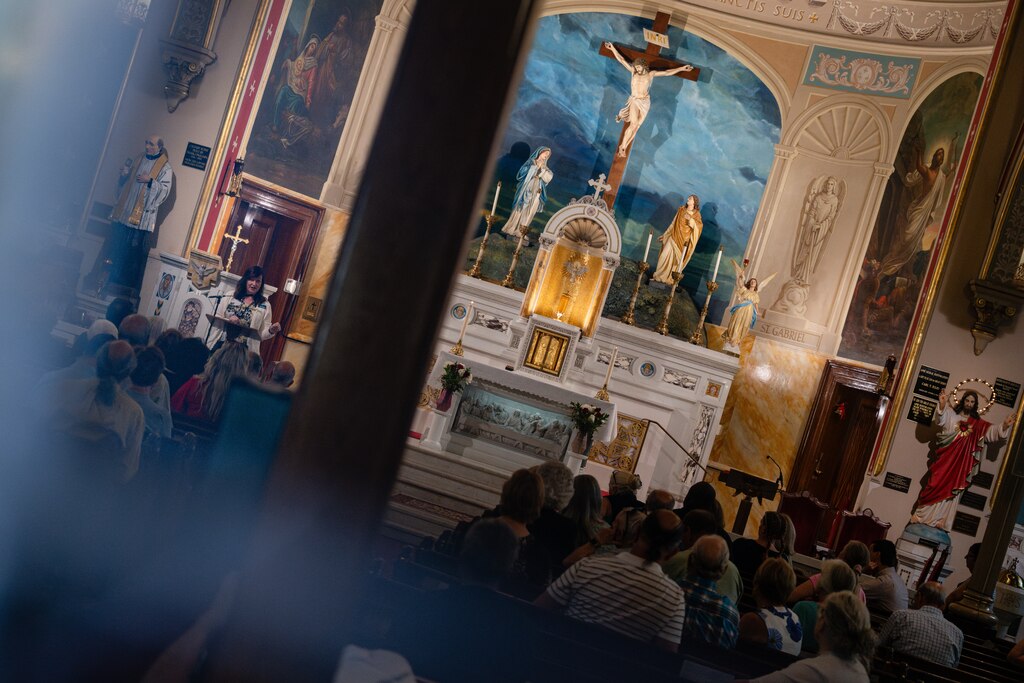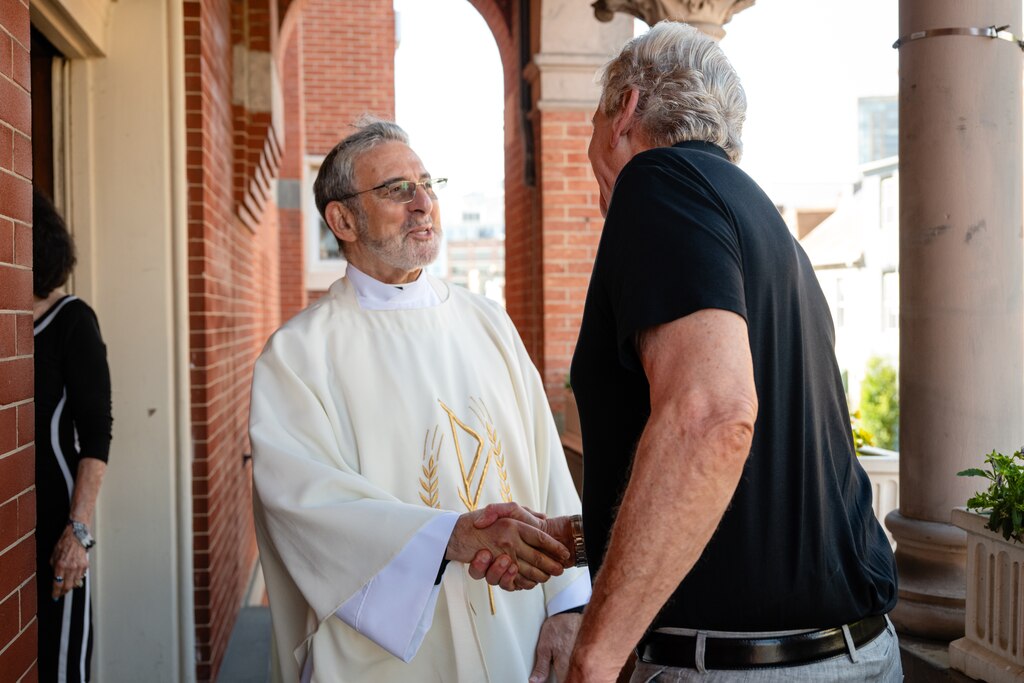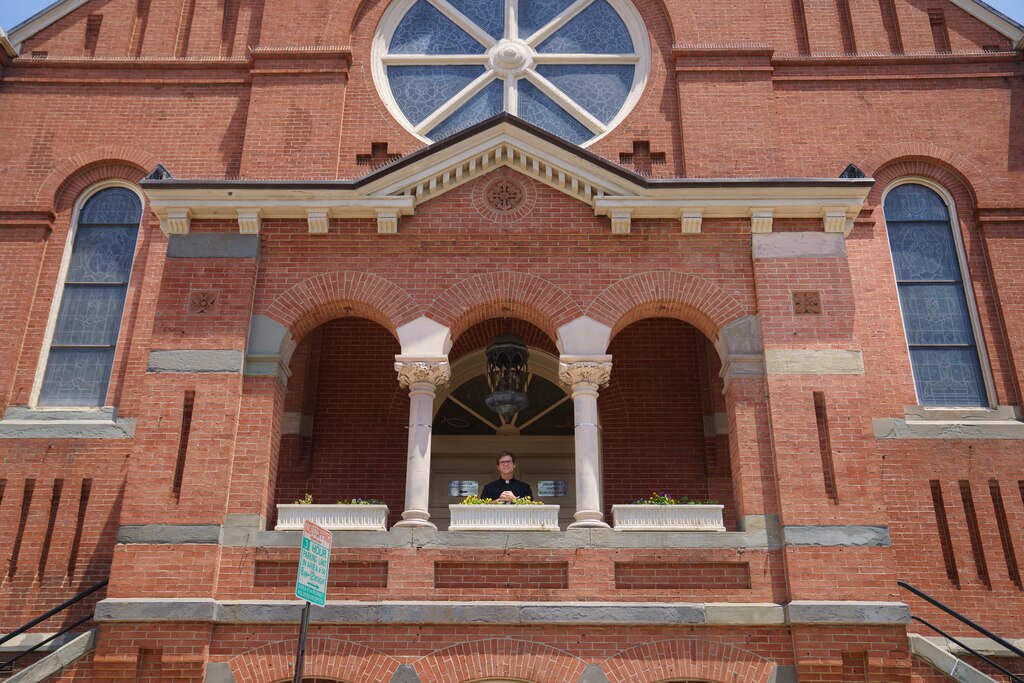Sitting in wooden chairs, parishioners listened to pastoral associate Colleen McCahill lead a lunchtime service as a fan whirred behind them and a mosaic window cast color on a wall.
McCahill has led such Word & Communion ceremonies, which take place when a priest isn’t present, at St. Vincent de Paul Catholic Church for 12 years. Wednesday’s was her last.
“This is a personal loss to me,” McCahill told the five people gathered in front of her. “Being with you, here, has made me better.”
On Tuesday, St. Vincent de Paul, the city’s oldest Catholic parish church in continuous use and one known for its legacy of inclusion and social activism, will merge into St. Leo the Great Roman Catholic Church in Little Italy to form a single parish.
The merger is the latest change to result from the Archdiocese of Baltimore’s Seek the City to Come initiative, which has led to church closures across the city and parts of Baltimore County. The archdiocese said dwindling Mass attendance and the cost of maintaining older church buildings necessitated the moves.
Although St. Vincent initially appeared on a list of churches set to close by the end of 2024, the two parishes were given additional time to take in the merger, work out a plan and appeal the decision if necessary.
Now changes are coming swiftly to the two historic churches, which are located less than a mile apart.
In February, the archdiocese announced that both churches’ pastors — Father Ray Chase at St. Vincent and Father Bernie Carman at St. Leo — would be retiring.
“Because this has been such a powerful experience for me personally, as well as spiritually, it’s hard to say goodbye,” said Chase. “Yet I understand that this is important in terms of assuring that this new parish will have the chance to become what we all hope it will become.”
Parishioners are processing other changes, too, such as the discontinuation of all but one Mass at St. Vincent, and of a popular Sunday morning Mass at St. Leo.
Read More
Father Evan Ponton, who will lead the unified parish, is hopeful the two church communities can work through any issues. He said both churches will remain active, with finances and ministries to remain separate.
Still, some parishioners say the changes have left them feeling uneasy.
Pat Ball, who has been going to St. Vincent for 50 years, said many parishioners are sad that it will no longer be its own parish.
St. Vincent and St. Leo “could not be more different in the members of our parish and in the types of liturgies that we celebrate,” Ball said. “It’s hard to try to merge them into something that’s exactly the same.”
Less than a mile apart but very different
With its distinctive white Georgian tower, St. Vincent de Paul is a familiar landmark near the entrance to Interstate 83. The parish was founded in 1840, initially catering to Irish immigrant laborers.
It has a long legacy of social justice and outreach — particularly for the surrounding homeless community. In addition to free Friday night dinners and a men’s clothing program, the church houses the Catholic Labor Network, a Peace & Justice Committee, and women’s and LGBTQIA+ ministries.

In February, St. Vincent hosted a Mass of Welcome and Love for the LGBTQIA+ community.
St. Leo offers a history that is nearly as long and quite different. It was the first church in Maryland built specifically for Italian immigrants, a place where future House Speaker Nancy Pelosi would later attend Mass as a child. Established in 1881 and nestled in the heart of Little Italy, the church, built of brick with stone trim, continues long-standing traditions such as neighborhood processions and an annual Italian festival.
Some parishioners at St. Vincent said they felt the archdiocese’s decision to fold it into St. Leo reflected an anti-progressive bias.
Maureen Daly, who was drawn to St. Vincent decades ago for its liberal activism, questions why the merger is taking place.
“They have been infuriatingly uncommunicative about why they chose what parishes they chose to close,” said Daly. “As a very progressive parish, we felt that the progressive parishes were being targeted.”
Christian Kendzierski, a spokesman for the archdiocese, referred to a February decree issued by Archbishop William Lori about the merger.
The decree cited a dwindling number of Catholic households in the St. Vincent parish, declining Mass attendance, an aging population, a lack of implemented archdiocesan guidelines and the proximity to several other parishes.
“At all stages of the process, the Archdiocese worked closely with the faithful to incorporate the gifts of all parishes and people in a plan that seeks to benefit the wider community.” he said.
Daly and other parishioners don’t believe the archdiocese considered the ways in which the parish has been growing. “When we pay our bills and have a decent turnout every week? Why?” she asked.
Ponton hopes the merger will allow for collaboration between the two church communities.
“I think one of the most refreshing and beautiful aspects of our churches is that our faith doesn’t fit into one political platform,” Ponton said. “We’re better together, because together we have a much fuller voice to speak to the relevant issues in our day.”

Ponton has been serving as associate pastor at St. Francis of Assisi, one of seven churches that was merged into a single parish late last year. It remains open as an auxiliary worship site.
“I know from my experience here the past couple years that change is difficult, emotionally and spiritually,” Ponton said. “There will be a process of grieving that we’ll go through, but I’m just trying to remain hopeful.”
Coming together
Church leaders hope the process will be smoother because of the work of an interparish committee that was established. It is composed of representatives of both parishes and the archdiocese.
The committee organized a joint Mass that drew 200 people and held five public “Dream Sessions” through May that allowed congregants to meet and make recommendations.
Many of the logistics, such as how staffing will work, have yet to be determined.

Some St. Vincent parishioners are holding out hope that it can be maintained as a stand-alone parish.
Dan McCarthy was one of about 10 parishioners at St. Vincent who filed an appeal to the Vatican regarding the decision. The group does not know when it will hear back but hopes it won’t be long.
“I’m hoping that it’s successful, but if it’s not, we make the best thing that we can from the situation we have,” McCarthy said.
St. Leo parishioner Salliann Alborn is more optimistic — perhaps stemming from the clarity she’s gained as a member of the interparish committee.
“If we work together, we will create something new and stronger that meets the needs of our existing parishioners and creates a welcoming environment for new people who come to this parish,” Alborn said.
Feeling uncertain, confused
A little more than a week before the merger, parishioners at St. Leo milled around the church after Sunday Mass.
Later, church leaders held a question-and-answer session to provide clarity for parishioners.

Joseph Wilkins, who has attended St. Leo for over 20 years, attributed confusion — some thought St. Leo was closing, others that nothing was changing — to the fact that the perceived outcome of the merger was constantly changing.
“You can’t start a process like this and not have some idea where you want to end up,” Wilkins said. “Part of the frustration is, after this two-year process, things still pivot.”
The most significant topic of conversation at the town hall was the change in Sunday Mass times. At St. Leo, the 9:30 a.m. and 11:30 a.m. Masses are being replaced by one service at 11 a.m. At St. Vincent, the Sunday Mass will be moved back an hour to 9 a.m., in order for Ponton to lead services at both churches on the same morning. Weekday and Saturday Masses at St. Vincent are being discontinued.
According to Nicholas Amato, the interim pastor at St. Leo, the earlier Mass tends to attract older members, while the later one draws younger crowds. Both groups tend to have different ideas of what Mass should be.

He doubted that St. Leo parishioners would shift to the Sunday Mass at St. Vincent, largely due to the difference in liturgies.
Many of those who attend the 9:30 a.m. Mass at St. Leo and socialize afterward worry they will lose their sense of community.
“You only lose a customer once,” Wilkins said. “So, if people decide they’re going to go somewhere else, even if it’s just during the summer schedule, you might not get them back.”
New pastor hopeful
Ponton said the vision for the parish will emerge as the parishioners want it to.
“We’ll continue the mission of what it means to be Catholic, which is to serve, to worship, to have fellowship and community, and see what kind of new ideas and insights come out of the change,” Ponton said.

After Wednesday’s noontime service at St. Vincent, McCahill said some parishioners talked about where they might go next for weekday Mass.
She said the weekday services draw some of the parish’s most devoted members.
“Even this is a community,” McCahill said, nodding her head toward the small group in a cluster of chairs.
On Sunday morning, Chase led his final Mass at St. Vincent. He compared the merging process to St. Vincent’s holy logo, in which people grab on to an anchor in the shape of a cross.
“This is a church where people don’t leave after Communion,” Chase said, looking toward the congregation area. “They always stay until the last song.”



Comments
Welcome to The Banner's subscriber-only commenting community. Please review our community guidelines.